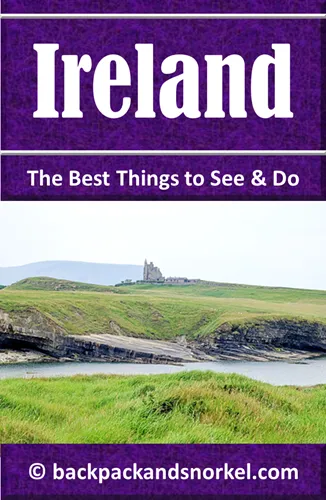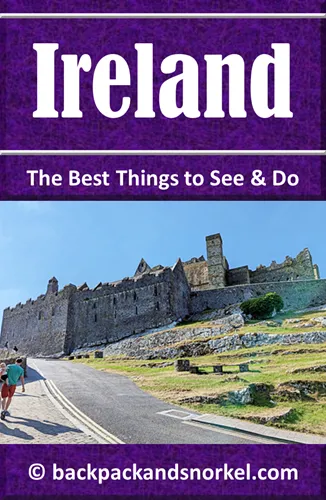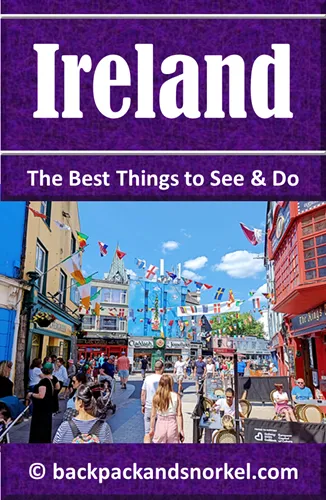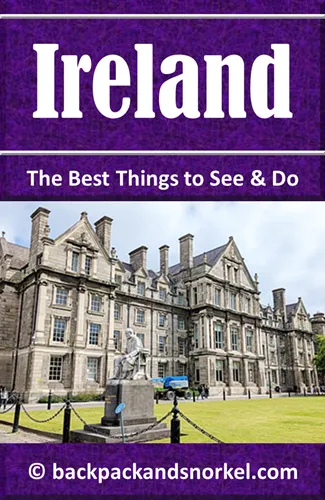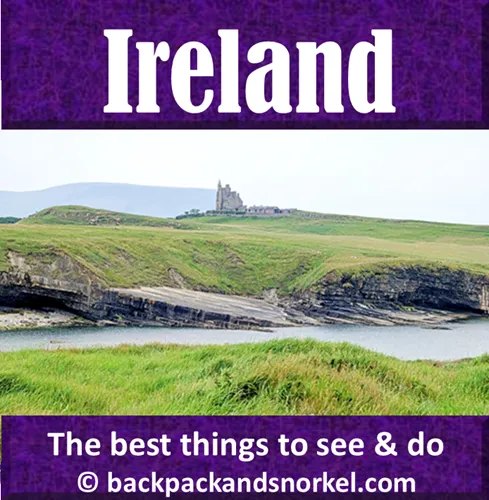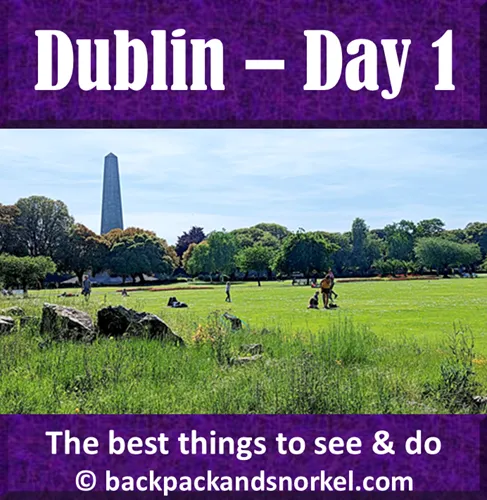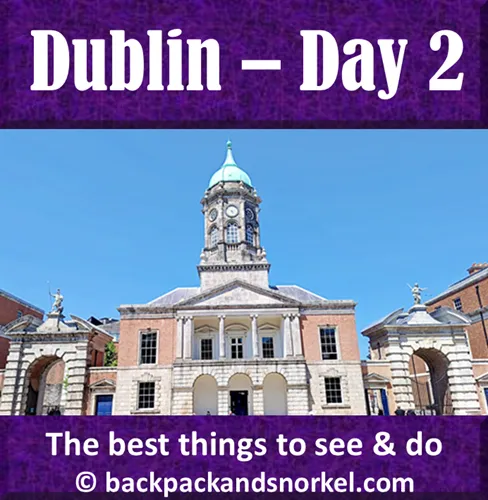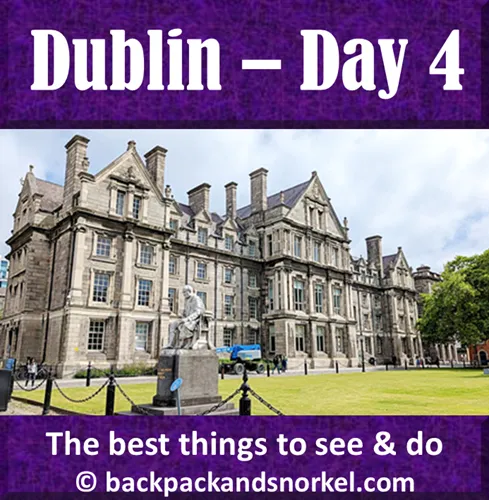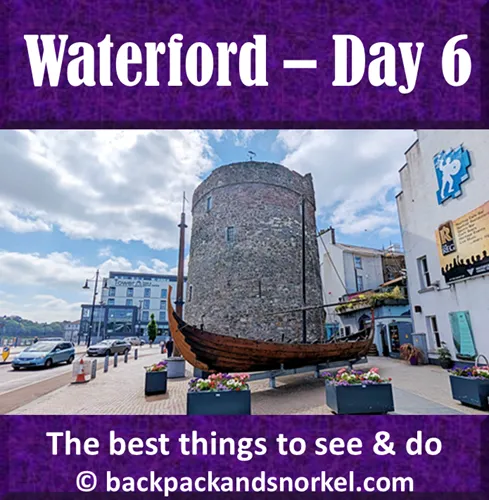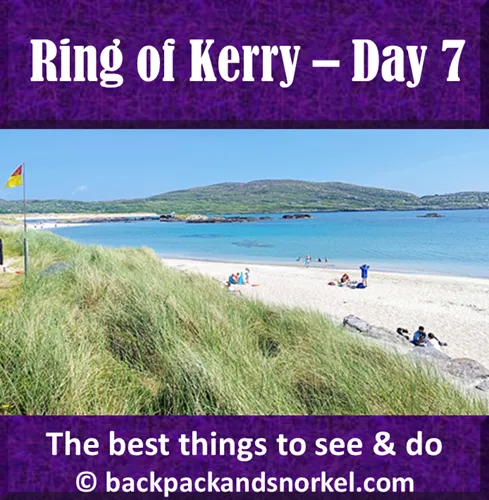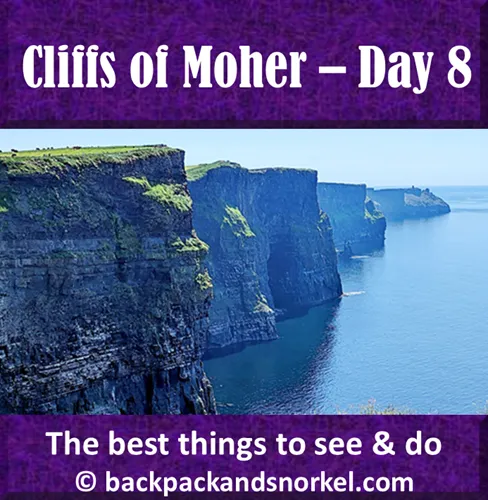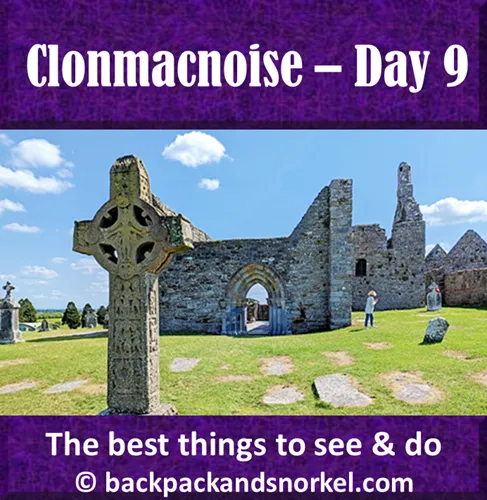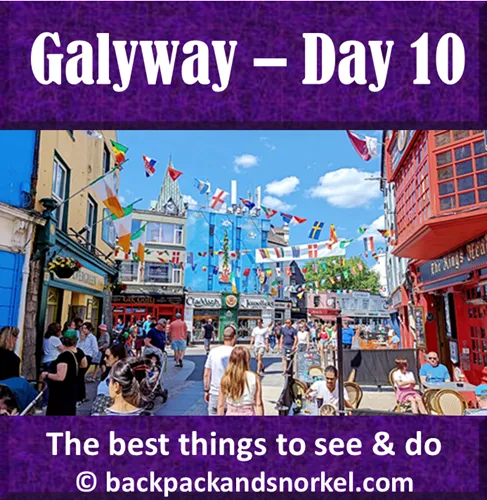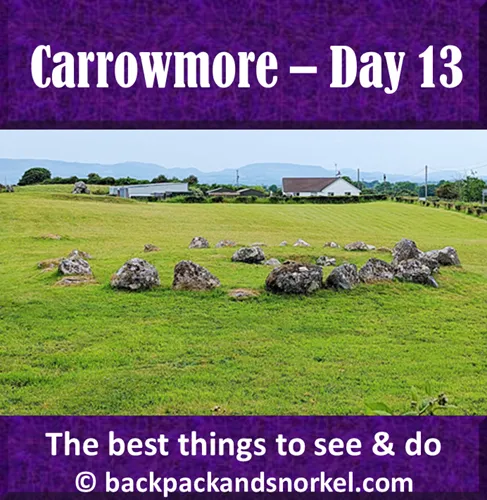Backpack and Snorkel Travel Guide for Ireland - Ireland Purple Travel Guide
Ireland is a beautiful country with stunning scenery like green rolling hills and rugged seaside cliffs, including the Cliffs of Moher.. We provide detailed information and the best things to see and we show lots of photos so you know what you can expect.
Inspired by Ireland’s lush green landscapes, Johnny Cash wrote the song called 'Forty Shades of Green'.
Ireland is also known for its rich history of nearly 10,000 years, and many castles…apparently 30,000 of them! With a population of a bit over 5 mio people, which is one castle for every 170 people.
In addition to the castles, Ireland has an uncounted large number of abbeys, priories, friaries, and other monastic religious sites.
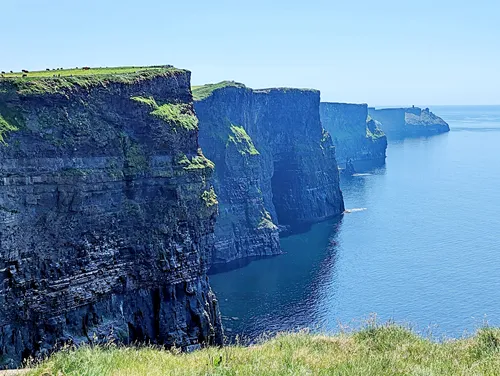
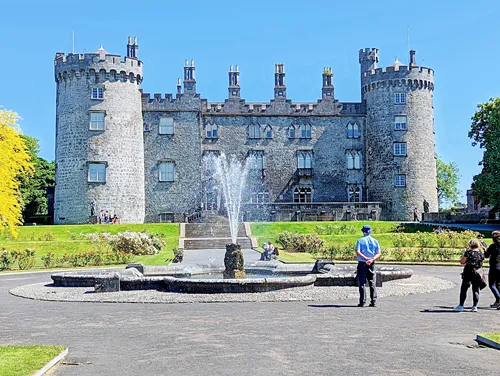
Table of contents
General Information about Ireland
How much time do you need to visit Ireland?
Ireland can be visited in 1-week, 2-week, or longer itineraries. If you have one week, then you should focus on one particular area of the country, if you have 2 weeks or more, then you can explore the major highlights of Ireland and Northern Ireland.
In this Ireland Purple Travel Guide, we present a 2-week itinerary for both countries that you can use as is, or you can tailor it to your interests.
You can find the itinerary here.
What is the best time to visit Ireland?
The weather in Ireland is defined by mild summers and cool winters, without any large temperature extremes. In summer, temperatures will often stay at or below 70 F (20C) and in winter, temperatures will usually stay a few degrees above freezing.
Rain is constant throughout the year – there is typically some rain on 10 - 13 days per month, but it is seldom a washout.
The best time to visit Ireland is in summer.
- June - August: This is the peak tourist season in Ireland – the hotel and airfares rates are at their peak and many attractions will be crowded and reservations are strongly advised for many attractions. The days are long and the temperatures are mild. Rain is possible any day, but during the summer months, you normally see less of it.
- September - October: This is the shoulder season. Hotel rates and airfares go down a bit and there are fewer tourists. The weather is cooler and you can be lucky and have great weather, or you can have a cool fall and lots of rainy days.
- November - February: The days are short; and the weather is wet and it is cold. Except for the time around the Christmas holidays, hotel prices and airfares are at their lowest point of the year and the number of tourists is small.
- March - May: This is shoulder season. Prices are still reasonable (except at around St. Patrick’s Day) and Spring has sprung. It is still cool, and the weather can be hit or miss. In some years, there is a lot of rain, in others it will be beautiful and dry. Unfortunately, it is impossible to forecast.
Below is the climate that you can expect on your trip to Dublin in Ireland:
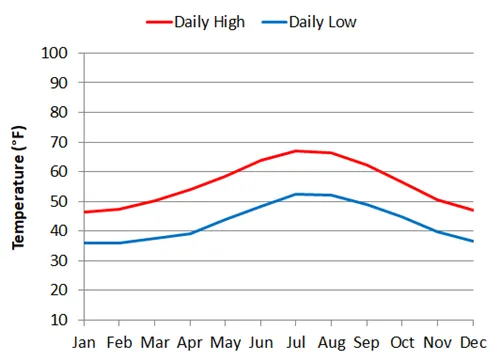
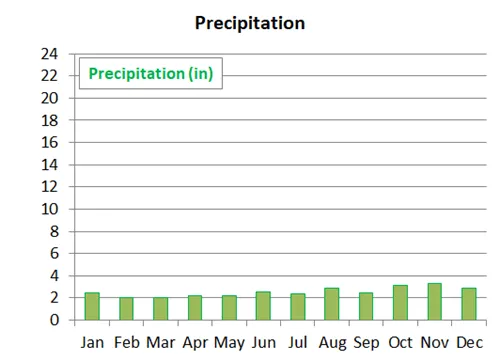
Below is the climate that you can expect on your trip to Galway in Ireland:
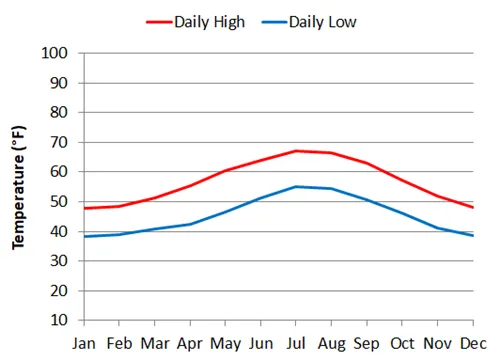
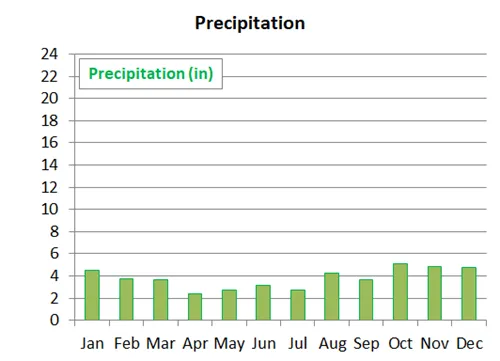
The highlights of the history of Ireland
- 31,000 BC: humans live in Ireland -> one reindeer bone with chop marks consistent with butchering with a flint or stone tool has been found in a cave 22 miles (36 km) north of Cork
- 115,000 - 16,000 BC: Ireland is periodically covered with ice that is more than 10,000 ft (3 km) thick, resulting in an ice bridge between Ireland and Great Britain
- 14,000 BC: the ice bridge only exists between Northern Ireland and Scotland
- 12,000 BC: the ice bridge is gone - Ireland and Great Britain are completely separated
- 8,000 BC: middle stone age communities are present in Ireland
- 4350 BC: farming of crops and domesticated animals (cattle and sheep) in multiple locations in Ireland. People start building megalithic monuments - more than 1,200 are known today
- 3,500 BC and 3,000 BC: the oldest field system with dry-stone walls in the world is operated and the main crops are wheat and barley
- 2,500 BC: the bronze age starts and some notable inventions are: the wheel, brewing alcohol, textile weaving, skillful metalworking, oxen harnessing
- Sometime around 2,500 BC: The Bell Beaker culture expands to Ireland. The Celtic language is being brought to Ireland either during the Bronze Age or the later Iron Age
- 500 BC: the population is somewhere between 100,000 and 200,000 people
- 500 BC: The iron age starts in Ireland and written records are being created by Greco-Roman geographers
- 2nd century AD: Ptolemy calls Ireland Mikra Brettania (Little Britain) and Great Britain: Megale Brettania (Great Britain). He later uses the word Iouernia for Ireland and calls Great Britain Albion. The Romans call Ireland Hibernia and later Scotia
- 150 BC: Before 150 BC, items like vases, etc. have mostly European styles and afterwards, mostly show influence from Great Britain
- 100 BC – 300 AD: The Irish Dark Age leads to economic and cultural stagnation. Ireland is a patchwork of many rival kingdoms
- 432 AD: Romano-British Christian missionary Patrick arrives in Ireland. His work and the work of other Christian missionaries eventually leads to a collapse of the druid tradition
- 840s: The first High King of Ireland appears. A High King of Ireland is a king who claims to have or actually has, lordship over all of Ireland.
- 9th century: Viking raiders start plundering Irish monasteries and towns
- 1169: Anglo-Normans invade the Kingdom of Leister with 40 knights, 60 men-at-arms and 360 archers
- 1170: More landings by Anglo-Norman nobleman Richard de Clare, known as 'Strongbow', with at least 200 knights and 1,000 soldiers to invade other parts of Ireland – the military interventions were sanctioned by King Henry II of England
- 1171: Fearing that Strongbow will set up his own kingdom in Ireland, King Henry lands in Irland with a large army (at least 500 mounted knights and 4,000) to gain control over both the Anglo-Normans and the Irish – his move is supported by the Roman Catholic Church. Henry grants Strongbow the Kingdom of Leinster but seizes the rest of Ireland
- 1172-1175: fighting all over Ireland
- 1175: Henry II of England and High King Ruaidrí agree to the Treaty of Windsor, dividing Ireland into a Norman-held territory that acknowledges Henry as overlord, and the rest of Ireland with Ruaidrí as overlord
- 1176: The Treaty of Windsor falls apart and fighting starts again
- 1177: Henry II repudiates the Treaty, declares his 10-year-old son ‘Lord of Ireland‘, forms the Lordship of Ireland from the territory held by the Anglo-Normans and encourages the Anglo-Norman lords to conquer more territory
- Starting in 1169: Norman lords start building their own castles
- 1216: A version of the Magna Carta (the Great Charter of Ireland) is created by replacing London with Dublin and the English church with Irish Church
- 1297: The Parliament of Ireland is founded
- 14th century: More and more of Ireland comes under rule of native Gaelic chiefdoms
- 1367: The Irish parliament passes the Statutes of Kilkenny to uphold Norman rule and prevent assimilation of the Normans into the Irish society. English subjects must speak English and follow English law.
- End of 15th century: Irish culture and language, with some Norman influences, flourish and become dominant
- 1494: The Irish Parliament is rendered powerless by Poynings' Law (Statute of Drogheda) is enacted. It states that the parliament cannot meet until its proposed legislation is approved by Ireland's Lord Deputy and Privy Council and by England's monarch and Privy Council
- 1542: Henry VIII of England declares himself ‘King of Ireland’ in the Crown of Ireland Act to reestablish English rule over Ireland
- 1593 to 1603: In the Nine Years' War, the English prevail against an Irish confederation
- 1607: The Flight of the Earls (the heads of the Irish resistance and about 90 of their followers) marks the end of the old Gaelic order
- 1639-1653: The Wars of the Three Kingdoms decimate the Irish population by almost half
- 1672: The Test Act 1672 states that Roman Catholics and nonconforming Protestant Dissenters are not allowed to be members in the Irish Parliament
- 1740: During the famine of 1740, approx. 250,000 people (about 1/8 of Irish the population) dies
- 1782: Poynings' Law is repealed, giving Ireland legislative independence from Great Britain
- 1798: A rebellion led by the Society of United Irishmen with the goal of creating an independent Ireland fails
- 1800: Through considerable degree of bribery, and with funding from the British Secret Service Office, the British and Irish parliaments pass the ‘Acts of Union’ that merge the Kingdom of Ireland and the Kingdom of Great Britain and create the ‘United Kingdom of Great Britain and Ireland’, effective 1801. This leads to the dissolution of the parliament in Ireland and replaces it with a united parliament at Westminster in London
- 1829: Due to Daniel O'Connell’s (The Liberator) mobilization of Catholic Ireland, the Roman Catholic Relief Act 1829 is passed. It leads to the emancipation of Catholics by repealing the Test Act 1672
- 1845–1852: The Great Famine devastates Ireland and leads to the death of 1/3 or Ireland's population. 1847 is the worst year and is known as ‘Black '47’, about 1 million people die and more than 1 million emigrate, mostly to the United States and Canada
- 1879-1923: Economic depression causes civil unrest and the Land War and accelerates emigration. By the late 1800s, half of all immigration to the United States comes from Ireland
- 1914: after relentless campaigning, especially from Charles Stewart Parnell, for the 'Home Rule' (Irish self-governing), the “Home Rule” bill passes, but temporarily excludes the six counties of Ulster, which will later become Northern Ireland. The bill is, however, suspended during World War I
- 1916: The Easter Rising of Irish Republicans for an independent Irish republic is quickly ended by British troops. British executions of their leaders and the arrests of thousands of nationalist activists strengthens support for the separatist Sinn Féin
- 1918: The pro-independence republican party, Sinn Féin, overwhelmingly wins the general election
- 1919: Sinn Féin proclaims an Irish Republic and sets up its own parliament. In response, the Irish Republican Army (IRA) starts a three-year guerrilla war
- 1921: The Anglo-Irish Treaty ends the hostilities and ends British rule over most of Ireland with the exception of Northern Ireland which remains within the United Kingdom
- 1922: The Northern offensive of the IRA fails and an 11-month civil war among republicans erupts over the interpretation of the Anglo-Irish Treaty
- 1950s: Large-scale emigration (> 500,000 people) mostly to Britain, but also to the USA due to poor economic conditions
- 1980s: Large-scale emigration mostly to Britain, but this time more to the USA due to poor economic conditions
- Mid-1990s – late 2000s: A period of substantial economic growth fueled by foreign direct investment occurs and it is called the Celtic Tiger. The Irish economy expands on average by 9.4% per year
- 2008: The global financial crisis ends the economic boom period and Ireland falls into a long deep recession
Driving a car in Ireland
Cars are driven on the left-hand side of the road. It is important to note that many Irish roads are extremely narrow and opposing traffic may only be a few inches (cm) away from your car on certain roads.
- The Motorways (M Roads) are beautiful wide highways, with two lanes in each direction and often very little traffic, unless you are in the big cities. Unfortunately, there are only a few of these roads. Some M roads are toll roads.
The speed limit is 120 km/h (75 mph). - The National Highways (N Roads) typically have one lane in each direction and a speed limit of 100 km/h (65 mph). In many cases it is possible to drive the speed limit on the N roads. But sometimes they are not wide enough of the view forward is limited so that you have to drive slower.
- Regional Roads (R Roads) and Local Roads (L Roads) have a speed limit of 80 km/h (50 mph). They form the majority of the roads outside urban centers. Those roads are sometimes so narrow that two cars can barely pass each other, and sometimes they are too narrow to allow cars to pass. In rare cases, these roads are compacted dirt roads. Bushes, trees, tall grass, or stone walls typically stand directly where the pavement ends and limits the view of upcoming traffic, especially with the many curves that these roads have.
You will barely ever be able to drive the speed limit or even get close to the speed limit on these roads. Driving at night is not recommended as there is usually no light.
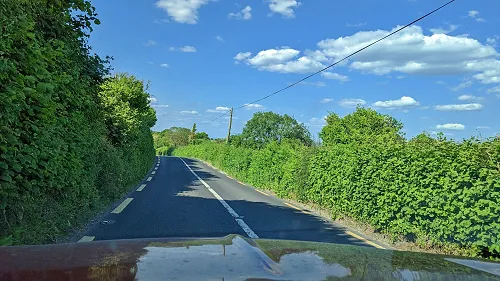
- Urban roads: Many Irish houses have no garages, so most people park their cars on the streets, making them very narrow to navigate. The speed limit in urban areas is usually 50 km/h (31 mph), but can be 30 km/h (19 mph) in areas with much pedestrian traffic.
In contrast to Northern Ireland, speed limits in the Republic of Ireland are in km per hour.
The many narrow roads, the fact that cars are driven on the left side of the road and the fact that almost all cars in Ireland have manual transmission, make driving in Ireland extraordinary difficult for many foreigners. It is absolutely manageable for experienced drivers, but our advice is to make sure that you get good insurance. Another piece of advice is: limit your daily driving, as navigating the narrow roads can be a nerve-wracking experience.
If you want to explore Ireland and follow the tour that we are outlining in this travel guide, then you will need a rental car.
Because of the many narrow R and L roads, we suggest that you do not blindly trust your GPS to pick a driving route for you. Review it and make sure that you drive the longest possible distance on M and N roads, even if that means taking a longer route.
The Irish love their roundabouts. Many roundabouts typically have two entrance lanes with arrows that show you which lane is best for which exit. So make sure that you get into the roundabout using the correct lane.
Most Irish drivers are courteous and safe drivers and you will rarely ever see them speeding, except on the M Roads. As a matter of fact, many will drive 10-20 km/h below the speed limit.
Lastly, be advised that much of downtown Dublin is closed to private vehicles. Dublin has an excellent bus system that allows for easy access to the downtown area.
Public Transportation in Ireland for rail and bus
Some cities, like Dublin, have excellent and frequent bus transportation. Dublin, as the only town in Ireland, even has a tram.
To travel between cities, you can either fly, take a bus or train.
- Trains: Many of the larger cities in Ireland have train stations. Trains in Ireland are operated by Iarnród Éireann (Irish Rail) and their trains are clean and reliable.
Belfast in Northern Ireland can be reached by train from the Dublin Connolly station.
Tickets can be bought online and at the railway stations. - Buses: Many Irish cities have excellent bus networks. In some cases, they connect one city to a neighboring town, but are generally not used for overland travel. The overland buses that you see in Ireland are operated by private companies for guided tours.
Buses in Ireland are operated by Dublin Bus in the Dublin area and by Bus Éireann in the rest of the country. The buses of both companies are clean and reliable. Bus stations often have electronic boards that show the arrival times and destinations of the next buses that will arrive.
You can buy tickets online or pay the fare inside the bus – exact change only as no change is given!
TFI LEAP Card: Instead of paying cash, you can buy a TFI LEAP Card online or from a TFI Leap agent and preload it with the money you expect to need and you can top it off if your balance runs low. TFI LEAP Cards are also available for Cork, Drogheda, Galway, Kilkenny, Limerick, Sligo, Waterford, and Westmeath. - LEAP Visitor Card: If you are planning to do a lot of traveling by bus in Dublin, then the LEAP Visitor Card may be for you. LEAP Visitor Cards are available for periods of 1, 3 or 7 days and they permit unlimited travel during the selected period on Dublin Bus buses.
If you plan to buy the LEAP Visitor Card online, be aware that it will be mailed to your home address – for international destinations, which may take several weeks!
Alternatively, there are a few agents in Dublin where you can buy one.
Money and Credit Cards in Ireland
The currency used in Ireland is the Euro. You can find the current exchange rate here.
Credit cards (MasterCard and VISA) are widely accepted, except on buses.
Tap water in Ireland
Tap water is safe to drink in Ireland, but it has a more or less strong chlorine taste and therefore we preferred to filter it to remove the chlorine taste.
Telephone
The country code for Ireland is: +353

In which Time Zone is Ireland
Ireland is on Ireland Time: UTC/GMT +1 h and observes Daylight saving time (DST).
You can find the current local time here.
Visa requirements for Ireland
As a part of the European Union, Ireland has the same entry regulations as the rest of the Schengen area. You can check if you need a visa to enter Ireland here.
Languages spoken in Ireland
English is the first and most commonly spoken language in Ireland. Irish (Gaelic) is the second language and you will find it on traffic signs.
Itinerary for your Ireland and Northern Ireland visit
The best way to experience this part of the world is by combining Ireland, and Northern Ireland. This can easily be done on a 2-week or 3-week trip.
The itinerary in this travel guide is a 2 1/2-week itinerary that will allow you to see the highlights of both countries.
You can use this itinerary as it is or modify it to fit your interests and travel style.
Please be advised that it can rain at any point on the island, so adding a few buffer days in the areas that you are most interested in can be a good idea.

Where do you want to go now?
Other popular Purple Travel Guides you may be interested in:
Like this Backpack and Snorkel Purple Travel Guide? Pin these for later:
